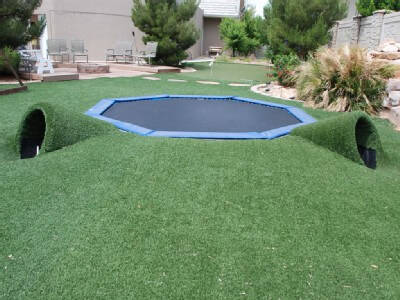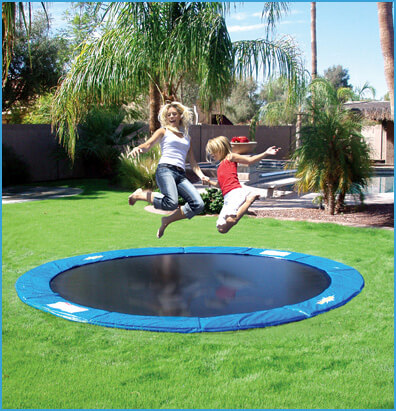Trampolines are very versatile pieces of equipment that can be used not only for recreational but health purposes as well. While most types of trampoline are above-ground, standing on legs, in-ground trampolines do exist and after a long time, they are gaining popularity.
These trampolines have their legs dug into the ground, and as a result, the jump mat is at the ground level. This does confer some aesthetic benefits, despite the more complex installation.
In-ground trampolines are considered to be the safer type when compared to other, above-ground models. The fact that the trampoline is installed in the ground is precisely what makes this type of trampoline safer as, during a fall, there is less distance between the jumper and the ground. Legs on standard trampolines can be quite high, some over 3 feet, even. That makes for a much more dangerous fall if it does happen.

Therefore, installing a ground system could prove to be a very smart decision. A number of accidents have been reported that derive from falling off the trampoline or falling through the springs. The occurrence of these accidents can be greatly reduced with the use of a trampoline enclosure, which prevents you from falling off the trampoline. That’s why enclosures are essential for in-ground trampolines as well!
Yes, in-ground trampolines without a safety net look the best, almost inconspicuous, but it’s also quite dangerous! Never purchase or install an outdoor trampoline without an enclosure!
Things to Remember When Installing an In-ground Trampoline
Having this type of trampoline installed brings you peace of mind, knowing how safe this type of trampoline is. But what about the installation? Have you thought about how exactly are you going to go about installing this into the ground – besides the obvious “duh, I’ll dig a hole”? It’s a tad more complicated, unfortunately.
There are a lot of things to bear in mind. This type of trampoline is considered the safest. However, you will also have to consider all the aspects and have answers prepared for questions like, “Do I have enough space where I can install it”, “Do I hire someone to do it for me?”, “How much is that going to cost me?” etc.
Installing In ground Trampoline
The installation may seem simple at first. Just dig a hole on the ground, install the trampoline, and Bob’s your uncle. Well, digging a hole in the ground is not an easy task, to begin with, much more than the installation after the digging. Not to mention all the dirt that you have to clear away, so having a hole with a retaining wall doesn’t make it half-done.

One of the most important things that you need to take a look at before installing a trampoline of this type is the drainage system of the area where you’re planning to install the trampoline into.
The area beneath should have a functional drainage system. Remember, there is a hole in the ground. Covering the hole with the trampoline will not prevent it from flooding. If you don’t do it properly, such a hole can become a breeding ground for all kinds of vermin.
In addition, a wall has to be put in place around the trampoline. This secures the position of the trampoline as dirt or mud will not be able to hold it and make it stable. In line with this, having a draining system as described above is a prerequisite.
- The key element in installing is thorough preparation of the area or the ground where the trampoline will be placed. The safety that trampoline promise is useless without this carefully planning this crucial step in installation.
- The walls in the ground have to be intact and secure. Otherwise, there’s a danger of the trampoline descending into the ground.
- There should be a drainage system in place and the quality of the dirt or the soil should be taken into account. A thorough analysis should be taken to find out if the ground is stable enough. Remember, this soil is what holds the trampoline.
- The hole in the ground where the trampoline will be installed has to be inspected and studied meticulously. The pit should be of the exact size as required. You cannot afford to allow oversights and inaccuracies in this detail.
- Ensure there is ample ventilation for the hole. Install flexible pipes running from the ground around the trampoline to inside the hole. This will ensure good airflow. Impeded airflow can make the trampoline very hard to bounce on as there is great resistance due to air being compressed.
After everything has been inspected, the last thing to do is to install the trampoline. This doesn’t take more than with the regular trampolines. If you are thinking about installing this type of trampoline, it is wise to get the best trampoline on the market. Try to do some research first and compare trampolines of the same type.
Even though not many models are available, the quality is mostly quite good. This way, you are assured of peace of mind and load of fun for your loved ones.

